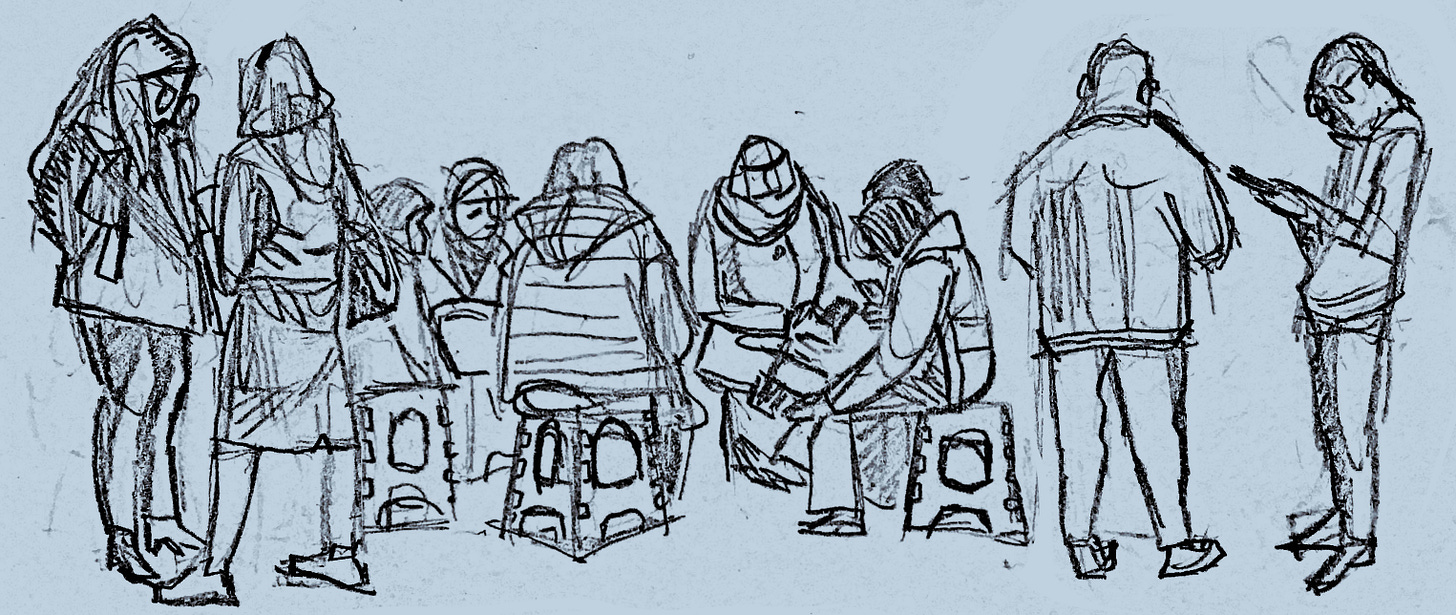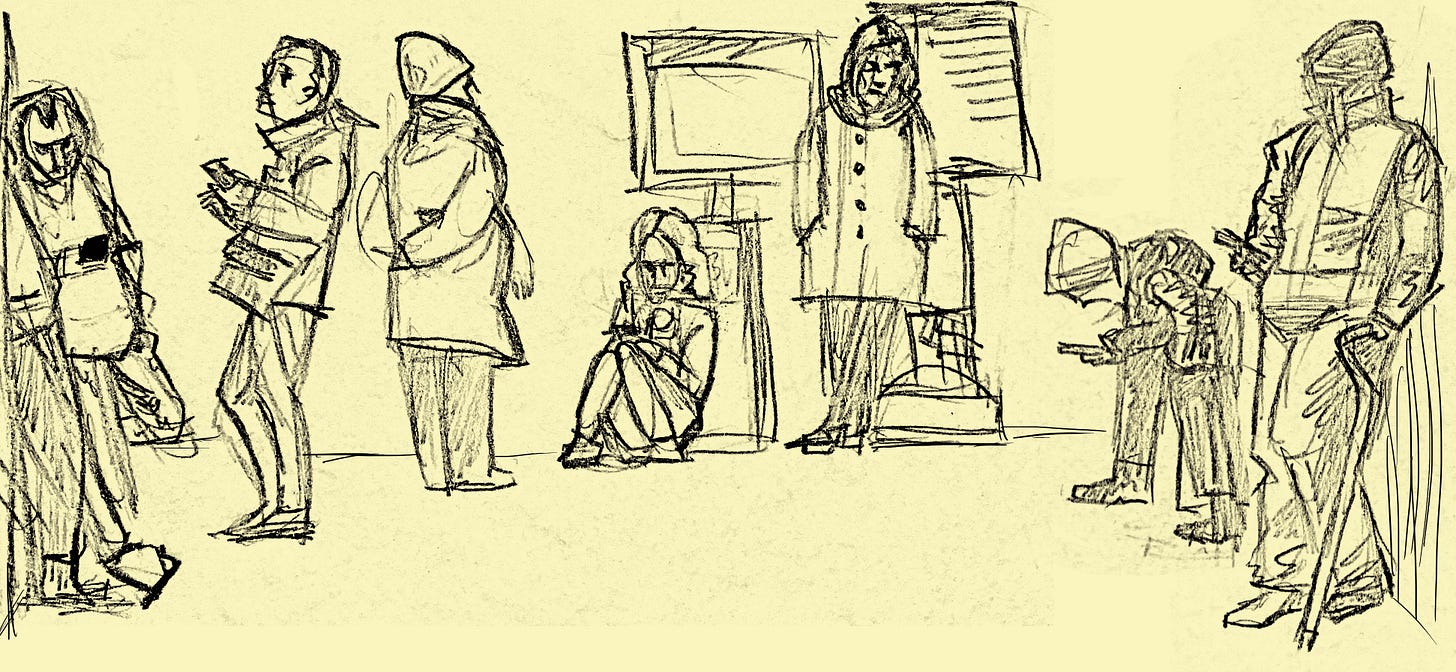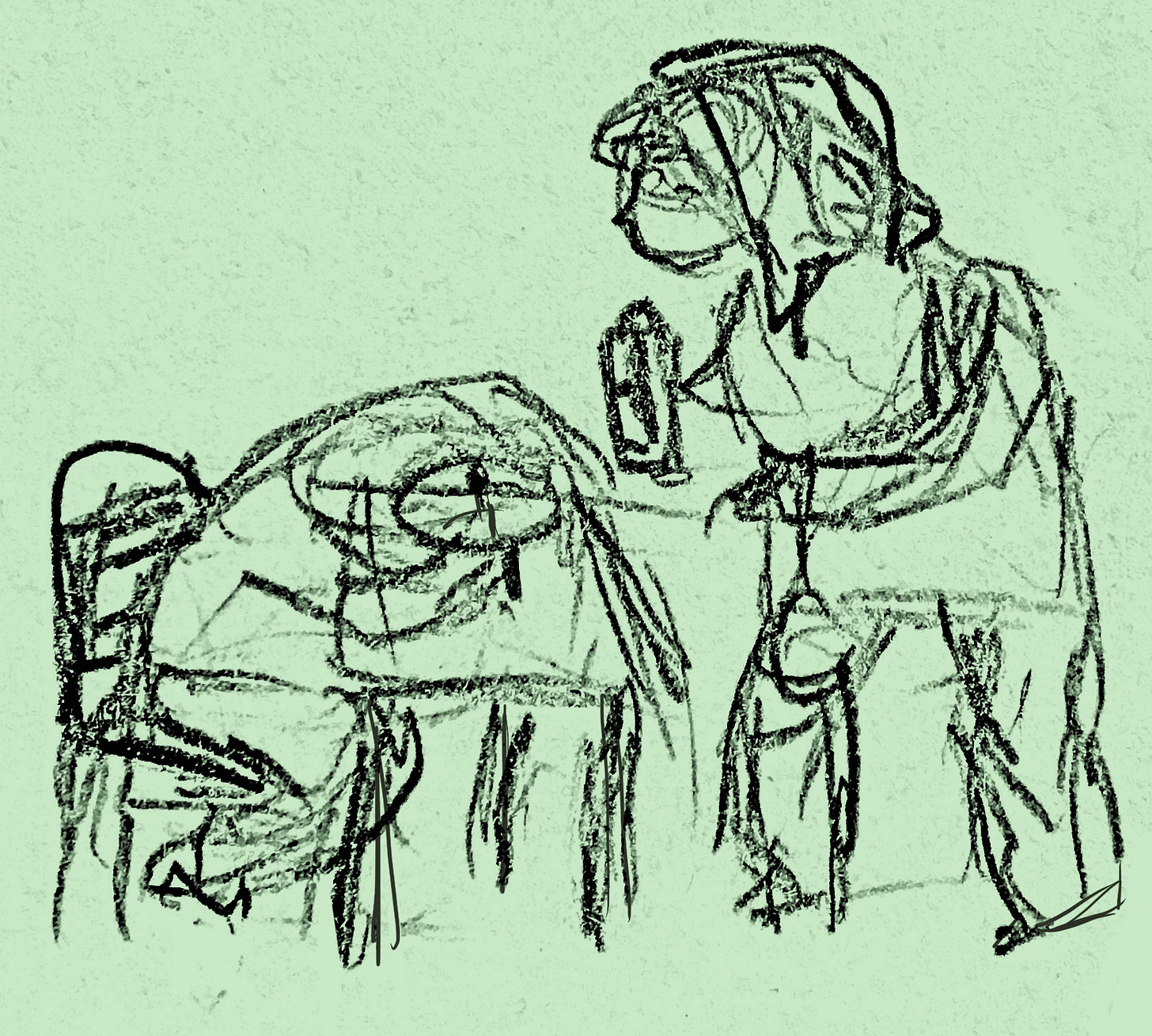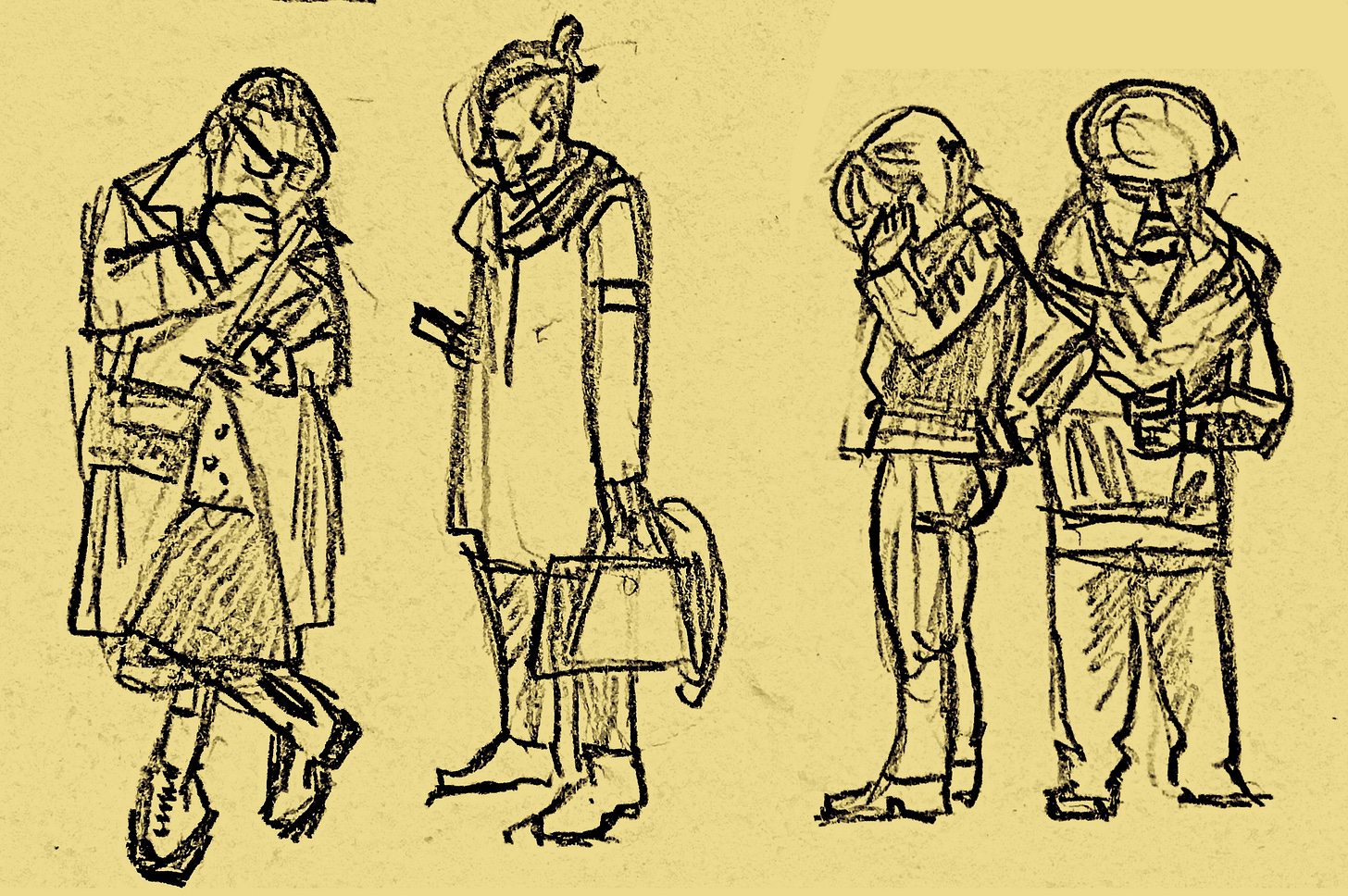Anxiety Part II
I could die because my language comprehension sucks
“Alarm,” ©2023 William L. Brown.
When the sirens sounded anxiety, there was no rush to shelter. First I’d check my phone to read and translate notices popping up on the Ukrainian Air Defense Telegram, (ППО [PPO]) channel, the Kyiv city channel and a couple of news channels.
As well as sounding the physical and phone-app sirens, the ППО identified the source of anxiety. The threat could have been as minimal as a Russian aircraft capable of carrying missiles taking off from an airfield in nearly Belarus. It might be unarmed, it might be a training flight. In which case, I could go back to sleep. Or it could have been a deadly wave of 100 missiles launched from russian ships on the Black Sea. In that case, I had about 30 minutes to get up, go to the toilet, get dressed and walk ten minutes to the metro stop.
Not everyone went to the shelter. On my way, I saw people strolling in other directions: dog-walkers, shoppers, parents pushing baby-strollers and Glovo bicycle-and moped-deliverers rushing past with their fluorescent-yellow oversize backpacks.
This was especially true in Dnipro, where the bomb shelters were not as nice as Kyiv’s. Dnipro doesn’t have an extensive metro system of underground stations to double as shelters, as Kyiv does. I saw one of their shelters near the Help Point where Ekaterina volunteers. It was just an underground pedestrian passage-way beneath the multi-lane Donbas Highway. It was damp and cold, very unpleasant in comparison with my local metro station, Klovska, in Kyiv.
Dnipro air-raid shelter/pedestrian underpass, October, 2022.
At Klovska there were almost as many folks outside than inside the metro station during an air raid. They lingered on the plaza near the metro entrance, having a smoke or a coffee. The espresso kiosks (“coffee points”) and shwarma stands next to the entrance had long lines.
Klovska’s entrance stairs lead down to a corridor complex under the street.. There are vendors in the corridors, as at most underground metro stations. Heavily-used stations can be small shopping-malls with coffee-points, manicurists, flower-sellers, shoe-shops, phone-repair shops, food kiosks, and so forth. built into the walls,
Klovska is not so exciting, though empty cubbies speak of better times pre-pandemic. Now, it has only three perpetual vendors sitting at tables. While sheltering, one can shop for women’s clothing and coats, housewares or baked goods. Two more substantial, official kiosks built into into the wall sell candy and produce.
Inside the station/shelter, I saw people standing or sitting on stools they brought with them. A small table and chair next to the guard’s booth was reserved for children. I never ventured as deep as the train-track level. I stayed, as did many, at the first level just below the street in the entrance room. Most of the crowd was on the side of the room before the turnstiles, though there was no charge to enter during an air-alarm. Almost everyone was engaged with their phone.
Sketch, ©2023 William L. Brown.
There was only one traumatic moment in the Klovska shelter - but it was more on the funny than the fright side. We could not hear any explosions inside, but a couple of times the electricity faltered and the roar of the great fans (or escalators, or whatever makes that roar) slowly died as pale emergency lighting clicked on. The crowd was nonplussed, they barely glanced up from their screens. Then we lost internet. There was a collective gasp of horror!
Incomprehensible
In Part One I explored the sources of trauma that apparently gave me writers block. There was no one big trauma, but several that added up to a problem. There was a cumulative effect too. One or two specks of dust on a window aren’t noticeable, but a steady accumulation of them starts to block out the light. Perhaps this is the one big trauma - the slow horror of diminishing resources.
Some of the more anxious moments were when I didn’t understand public announcements during missile/drone attacks. My Ukrainian is just not that good. It’s a gut-loosening feeling, and humiliating to a language teacher to think, “I could die here because my language comprehension sucks.”
Sketch, ©2023 William L. Brown.
Sometimes the fear was quieted by simply following the lead of those around me. Early in the visit an announcement at the supermarket was mostly incomprehensible but I soon got the gist as everyone around me set their shopping baskets on the floor and walked out - hungry.
It was not so easy at the Dnipro Vokzalna (train station). I was catching the train back to Kyiv. I arrived early, found a seat in the waiting room and asked the desk officer to tell me when my train was ready to board and what gate to go to. This was me being a savvy traveler. Gate assignments are made last-minute and are not always posted on the main board. I’ve had anxious moments at departure times, running from board to board and gate to gate to find my train. That problem was solved this time, I thought, but then the sirens wailed.
We were sent to the lower level, the pedestrian tunnel below the tracks. I could not understand the announcements, nobody I asked spoke English, or could deal with my bad Ukrainian – I told myself “probably Russian speakers.” Problem not solved, after all. I went from savvy to helpless.
The Ukrainian-news-in-English (my phone still worked) said the train line between Kyiv and Dnipro had just been bombed. Even so, after only a half-hour delay the boarding gate was announced. Surprisingly, many people went up the staircase to wait on the exposed platform. I was with the group huddled on the stairs. Everyone calculates their odds differently.
Another time, I was riding a Kyiv metro line that emerges from underground to cross the wide Dniper on an exposed bridge. Trains are not allowed to cross during air-warnings (cars and truck traffic is allowed). There was a warning so my train halted at an underground station en route. Passengers got off. I could not understand the announcements.
I knew I couldn’t cross the river. It seemed like trains were being redirected, but I could not understand where to. There were no available seats in the station, and my back began to ache. I could only pace the length of the platform, stand a while, then pace some more. I would have sat on the floor, but the air was damp and drafty and the cement was chilly, After two hours the all-clear sounded.
The fear in that case was not from bombs and rockets, it was the fear of not knowing what to do or how to get home, if it was still there.
Bombs or ballet?
People ask me if I heard explosions? Yes, certainly, and I described it previously. But on other occasions it was difficult to distinguish distant explosions from a neighbor’s kid bouncing off the walls. I heard these noises all through the pandemic. I’m not sure which neighbor’s child it was, either next door (girl) or upstairs (boy). Through the lockdown, neighbors avoided interacting, so we barely saw one another and never spoke. The child was trapped at home all day, much of it evidently spent throwing themself onto the floor, engaging with imagined enemies, unicorns, dance troupes, sports-teams, or playmates. I liked it. It was a sign of life in the middle of COVID isolation, it was also a homey, child-sound. My favorite years (so far) were the parenting years.
In this war year, however, it was unnerving. And I can’t say if, other than the Oct. 18 raid, I was hearing explosions in the distance or unicorns next door.
Dying of the light
The steady erosion of services and light had an emotional effect. Nature was doing this already, shortening the daylight hours. Darkness fell around 4 pm, a little earlier each day. Going out after dark is risky. There’s a danger of falling/tripping or getting hit by a car. Many street lights are out, and some traffic lights stop working at night. I returned one night from a candlelit pizza restaurant and came to a busy intersection with no traffic lights, some cars zooming through, others inching their way across, and groups of terrified pedestrians waiting to hazard a crossing.
And, then there’s the curfew. Everyone is supposed to be off the streets by 11:00 PM. So, small wonder there are not many people out in the evening, and many places close early, or have limited service. This contributes to the feeling of the darkness closing in and the diminishment of life.
In October, when i arrived in Kyiv I found my building was unaffected by the rolling blackouts happening elsewhere in the city. Those areas experienced two four-hour outages every day. The schedule was available online, you only had to key in your address. My address was not on the list, perhaps because there were hospitals nearby that needed constant electricity. Maybe it the proximity of government buildings. Or it could have been due to someone of influence living nearby.
No matter, within a couple of weeks I was on the rolling blackout list, and then, following a big attack, the power went out for a whole day. Weekly mass missile and drone attacks on power infrastructure knocking out the electricity, which knocked out the pumps that drive water and natural gas. Repairs were made quickly, but never fully. Slowly the energy capacity was falling.
See my Instagram account. I’ve been posting “one year ago today” photos and drawings: last days in Kyiv and hasty trip to Lviv to wait “until things blow over.”
Generator use became widespread in the private sector. One November day when my electricity and water were out in my house and neighborhood I walked down the hill one block to Klovska Square. The shops had generators lined up in front of their shops. Through the dog-grooming shop window I saw two small dogs getting shampoos. People strolled in and out of shops, cafes and the metro station. Це нормално -”It’s normal.”
But, generators are not usually an option for living spaces. Generators can’t be placed on balconies. Some upscale apartment buildings got industrial-size generators. One near me made a perpetual helicopter-like noise.
Sketch, ©2023 William L. Brown.
My last week in Kyiv, While Americans were preparing Thanksgiving dinner, it was my second day without water. I had plenty for drinking - nobody drinks tap water – like many Kyivians I order drinking water in 20 liter bottles - and I’d filled several containers with “mechanical water” for flushing the toilet. I was more anxious about my mechanical water running out than the drinking water, because I didn’t want to waste drinking water on flushing.
Return of the light
Lately, I’m glad to report, the light is coming back. Students in Kyiv report they’ve had uninterrupted electricity for eight days.
All of them, and the rest of the world, are anxious about how russia will mark the first year anniversary of the 24 February 2022 attack. One more anxiety to live with.
As for my writers block. I got two articles out in two days, and I have another planned for tomorrow to mark the 24th. So looks like I beat it, for now anyway. My motivation is stronger than the block, and that motivation is to get people to think of Ukraine, and to understand what the people there are going through. It may be a long battle.








This information does not come out on the news that I’m aware of. I had an unrealistic thought of what it would be like if people started rebuilding amidst the shelling and bombing. Could restoration defeat devastation. With China’s capacity to build 3D homes almost instantaneously it is too bad they choose Russia over Ukraine. What a wonderful idea to put political agendas aside and rebuild a new economically viable world to live and breathe in. As unrealistic as this may sound it is my hope before all is lost.